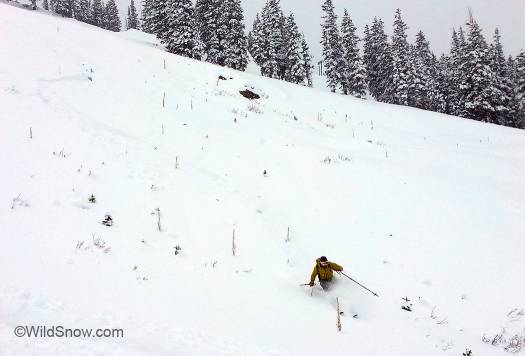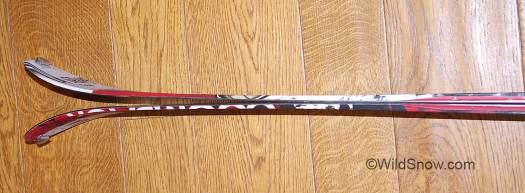
To demonstrate the massive commitment we have at WildSnow, we test skis in all conditions, including weeds. Here, Tyler substitutes a stem for a slalom gate.
Lou gains a nervous smile and a suspicious laugh when I start snooping around WildSnow headquarters. I think he is just glad he was able to hide the latest crop of carbon infused powder boards from my prying eyes.
I can never seem to get him to cough up an unfamiliar creation from who knows what manufacture. Excuses abound, although Lou mostly expounds on what he views as my destructive tendencies.
“I need my test skis back in a pair instead of 4 pieces,” he says, “that way a mere mortal such as myself can have a take.”

K2 Coomback 104
Lucky for me even the less exotic offerings are still just as much fun, and most are durable enough to honor Lou’s wishes. For example, recently I was able to pry some Coomback 104’s out of the Wildsnow arsenal.
K2 has forged a loyal following with their Coomback ski line and for good reason. The previous models balanced a sweet spot of float, edge control, damping, and pop. K2 seems to have updated this formula by adding a little width without the weight. Some other changes of note are the new sidewalls, tip and tail rocker and taper as well as snow-phobic topsheets.
The hybrid sidewall construction is a bit of a departure of K2’s more recent way of doing things. It can sound good, but in reality is something most skiers won’t notice in the store or on the slopes.
Theoretically the hybrid sidewall construction should give some additional edge purchase on the hard stuff, in practice its tough to notice that type of difference on anything but a race course.
K2 should be commended for adding a reasonable amount of rocker to this ski. All too often I see rocker marketing hype override common design sense.
Both the tip and tail taper and rocker make the Coombacks easy to initiate and release turns even in some of the breakable crust I tested them in. This characteristic seems to honor the late Doug Coombs, and his legendary predictability and poise on the steep stuff. Sitting at 136mm/104mm/122mm the Coomback enjoys a tried a true shape common in North American backcountry skiing.
The snow-phobic top sheet is a welcome addition, but it’s not perfect. During my tours the dark parts of the topsheet graphics were still able to accumulate icy snow while the lighter areas remained relatively snow free. To be fair this issue seems more prevalent climates similar to Colorado where we encounter solar top sheet heating from our bluebird days. Overall I would say this is a good improvement from other topsheet material on the market but a lighter graphic may have put the icing issue to bed forever. (WildSnow.com advocates light color ski topskins, some companies have aquiesed, but ski graphics designers want their say and don’t like pallet limits.)
While I think this ski will hold a wide appeal I did find some things that are worth considering. The normal uniform flex profile I’ve experienced from other K2 products seems to be modified. Where the ski switches from a cambered profile to a rockered profile the ski is notably softer than in the waist or in the relatively stiff tail. This flex pattern rewards a more neutral stance and required some adjustment to my typically tip initiated turns.

Coomback tip rocker profile. Note the Montana skin tip attachments, they’re nicely designed to use the tip OEM hole, and include a template for drilling your own hole if so desired.
While I’m not sure what magic K2 cooked up in the core of the Coomback I would have to assume there is a change in materials toward the tip of the ski to reduce weight. I don’t see this as a big issue with the ski, just something I could feel in more firm conditions. In softer conditions this flex pattern helped the ski float while in either a neutral or more aggressive stance. This ski performed commendably in the chop however the soft tip can be easily deflected at speed. The Coomback certainly has a speed limit but one most backcountry skiers will find adequate.
The Coomback individual ski weights at the 177cm length were Wildsnow verified at 1668 grams 1644 grams respectively. K2 lists them at 1650 grams which seems to be well within manufacturing tolerances we see from other brands. In my opinion this fits well in the human powered category for ski size and weight, though the “weight wars” are resulting in some amazingly light carbon skis that are skewing expectations.
Another feature of note; K2 keeps their traditional tip and tail holes that can be useful for some skin applications and rescue situations. This feature seems to be more and more elusive in modern backcountry specific skis. We are glad to see K2 kept this feature around; it’s for real people in the real backcountry on real skis.
Overall the Coomback 104 is a good update to a well loved ski. While there are wider skis out there the 104mm waist and rockered tip/tail allow the ski to float well for its size. The Coomback stays true to its roots but attempts to distinguish itself from previous resort or sidecountry oriented iterations from K2 with its weight and construction. On hard conditions the Coomback skis more similarly to other resort offerings while in soft conditions its performance is on par with other skis in the 100mm + waist category.
Don’t worry Lou, I’ll bring them back in one piece…..someday.
(Guest blogger Tyler Christoff Tyler Christoff grew up ski racing and tree farming. He knows how to use a chainsaw. He raced at Syracuse University, making Nationals multiple years. He is one of our favorite ski testers, even when he breaks stuff.)
Tyler Christoff grew up ski racing. He raced at Syracuse University, making Nationals multiple years. A few years ago he moved to Aspen to pursue a different sort of skiing. Tyler has rapidly grown into a strong mountaineer, and has the perfect form that most skiers only dream of. He is one of our favorite ski testers since he hits backcountry skiing regularly.
